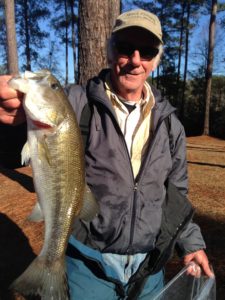Sunday, January 7, only five Flint River Bass Club members braved the icy cold to fish our January tournament at Jackson. When we took off at 8:00 AM it was a brisk 24 degrees, the wind was blowing and the water temperature was 45 degrees. At the 3:30 PM weigh-in we had 12 keepers weighing about 23 pounds. There was one limit and one zero. I was surprised there were five largemouth, usually spots are about all that hit in water that cold.
I got lucky and made a good decision or two and landed five weighing 10.97 pounds for first and had a 3.64-pound spot for big fish. Jordan McDonald had three at 5.91 pounds for second, Niles Murray was third with three at 5.18 for third and Doug Acree placed fourth with one at 1.38.
Knowing how cold it was going to be, I decided to set up a “milk run” of rocky points near the ramp. I did not want to ride far in the cold and wind, and rocky points are a good place to fish this time of year. So at blast-off I idled to a point near the ramp and started casting.
On my second cast a keeper spot hit my crankbait and I was thrilled. I knew I would not zero! Then a few minutes later I caught a largemouth on the same crankbait. It weighed almost three pounds so I was really happy. At 8:15 I landed another keeper spot on a jerk bait. That was a really good start, but it got tough after that.
I idled to another point and tried to fish it but the wind was blowing on it and my hands started burning. I missed a bite on a jig head worm. I thought I felt a bite but ice in my rod guides made the line scrape as I reeled it in, and I was not sure.
I dipped my rod into the water to melt the ice and before I could get back in position the fish took off and spit the hook. That was disappointing. A few minutes later I landed a largemouth that was just shorter than the 12-inch line on my keeper board.
After trying to fish some brush on a point in the wind I gave up and went back into a small creek that was somewhat protected from the wind. I would cast out a crankbait, reel it a few feet then have to dip my rod into the water to melt the ice. I just kept working around the creek, casting and dipping, out of the wind.
At 11:00 I got my next bite, the big spot. It hit the crankbait on a shallow rocky point. Four in the livewell with two decent fish. I started hoping I might catch a limit.
At noon I cast a jig and pig to some brush near a dock, got a bite and missed the fish. Knowing sometimes you can get another bite on different bait I picked up my jig head worm and caught another keeper largemouth, filling my limit.
For the next three hours I cast my crankbait and other baits. It was finally warm enough that ice did not form in my guides. At 2:00 I caught a keeper spot on the crankbait that was slightly bigger than the one in the livewell so I culled.
At 3:00 I went back to the point where the big one hit. With ten minutes to weigh-in Niles and Zero rode by headed to the ramp. Then, as Jordan came by, I caught my last fish with five minutes left. It was a keeper spot that hit my crankbait and culled my smallest fish.
I never got my boat faster than idle speed all day. And it worked!


